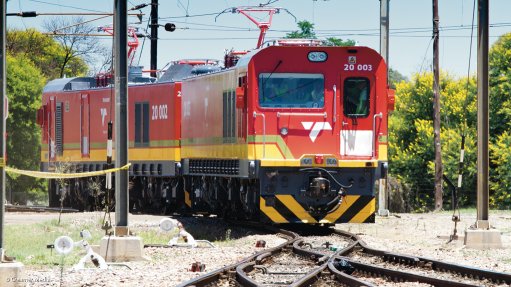Single air transport market could add impetus to lagging recovery of African carriers
The post-Covid-19-pandemic recovery of the African airline industry is lagging behind that of other regions of the world, but it is recovering, International Air Transport Association (IATA) External Affairs & Sustainability: Africa & Middle East regional business development manager Sandile Chipunza pointed out at the recent Board of Airline Representatives of South Africa (BARSA) conference, in Cape Town.
African airlines’ annual traffic last year was up 89% on that for 2021, and reached 86% of the levels recorded before the pandemic, he reported. The continent’s airlines registered total losses of $638- million last year, which were forecast to decline by 66% this year, resulting in total losses of $213-million for 2023.
However, IATA forecasts that, globally, the airline industry will make a profit of $4.7-billion this year, from total revenues of $779-billion. Last year, worldwide, the sector recorded a loss of $6.9-billion. Over the period of the pandemic, airlines globally suffered total losses of $42-billion.
Returning to Africa, the continent’s airlines last year also registered a 51% increase in capacity, compared with 2021. Their average load factor rose to 71.7%, but this was the lowest figure for any of IATA’s regions. “[W]e know each [African] sub- region moves at its own pace, reflecting its unique advantages and obstacles,” he cautioned. “Some have seen demand return faster than others.”
Connectivity
Africa is the world’s second most populous continent, yet currently accounts for only 2.1% of global air passenger and cargo traffic. This is the result of the lack of air connectivity within Africa. This, in turn, is a consequence of barriers imposed, by African countries, to access to their markets by airlines from other African countries.
“Connectivity is precious,” highlighted Chipunza. “The pandemic demonstrated that everyone suffers when aviation stops. It also dispelled the myth that flying only benefits the rich. (We say in IATA – Aviation is the Business of Freedom.) A financially viable air transport sector, in a fit-for-purpose and enabling regulatory environment, supports jobs, promotes transformation and will be a driving force for Africa’s economic recovery and future growth.”
“The only way politicians and governments will successfully meet everyone’s ambitions for a prosperous and sustainable future is through intra-African trade, travel, transport and cultural exchange,” agreed South African private-sector airline Airlink CEO and MD Rodger Foster in an exclusive interview with Engineering News & Mining Weekly. “Because of the distances and terrain between destinations on our continent, competitive, reliable, affordable and safe air connectivity will be crucial.”
And recently-appointed South African Transport Minister Sindiswe Chikunga also agreed. “We all know that air transportation plays a pivotal role in enabling economic activity that enables growth through rapid movement of goods and people,” she said at the BARSA conference. “Growth in air transportation directly contributes to this growth through the creation of direct and indirect jobs in the industry and other auxiliary sectors, such as tourism and the services sectors.”
Single Market
“The solution for us here therefore is to immediately create, bolster and support a conducive environment that enables airlines to operate sustainably by competing robustly to allow viability and profitability in the airline industry,” affirmed Chipunza. “The current regulatory regime must be reviewed to ensure it is fit for purpose.”
And there is indeed a transcontinental programme to create such an environment: the Single African Air Transport Market (SAATM). Such a concept was originally proposed, by the World Bank, to the then Organisation of African Unity (OAU), in 1988, but it totally failed to gain traction. This was followed by the Yamoussoukro Decision in 1999, under which 44 African countries committed themselves to the deregulation of air services. The Decision was endorsed by the OAU in 2000 and came into effect in 2002 (which year also saw the establishment of the African Union, or AU, which replaced the OAU). Unfortunately, progress was again slow, but in January 2018 the AU launched the SAATM as a flagship project, under its Agenda 2063 programme.
Further, to accelerate the implementation process, last year a SAATM Pilot Implementation Project (PIP) was initiated, under the aegis of the African Civil Aviation Commission (AFCAC). This involved, as an essential preliminary, the creation of an SAATM Enabler Index. This index is composed of four broad elements: aviation policies and regulations, country performance indicators, infrastructure, and safety and security. Each element, in turn, contains a number of aviation-specific features and policies. The overall result allows an evaluation of how well a country was coming into line with the requirements of the SAATM.
The SAATM Enabler Index resulted in 13 States being identified as having “favourable environments” for the implementation of the SAATM. They are Cabo Verde, Côte d’Ivoire, Ethiopia, Ghana, Kenya, Morocco, Mozambique, Namibia, Nigeria, Rwanda, South Africa, Togo and Zambia. Except for Zambia, all have domestic airlines that qualify to participate in the SAATM. (Of these, Cabo Verde, Côte d’Ivoire, Ethiopia, Ghana, Mozambique, Nigeria, Rwanda and Togo have signed a Memorandum of Implementation.) AFCAC is hopeful that, by November this year, at least three of these countries will have signed new SAATM-compliant Air Service Agreements between themselves. That will be enough to start the SAATM, albeit on a small scale.
Devilish Details
“It is relatively simple for governments to sign a solemn declaration of intent to apply the SAATM principles and open their markets to carriers from other countries,” cautioned Foster. “However, what counts is ensuring that every base is covered so that there is no room for back-door protectionism by the unilateral, uneven and inequitable application of regulatory and other statutory charges by participating countries. This has become evident with the SAATM PIP and we have appealed to the [South African] Ministry and Department of Transport to insist that other African countries treat South African carriers in exactly the same way, with the same privileges, traffic rights and charges, as their airlines are granted by South Africa.”
Nor was this all. Foster pointed to the absence of a harmonised pan-African definition and understanding of the criteria, protocols, processes and tariffs to be applied by each country’s competent authorities in the issuance of Air Operator Certificates and Foreign Operator Certificates to airlines from other States. Similarly, there are inconsistent understanding and interpretation of air traffic rights, including the different ‘freedoms of the air’. (These determine if flights between two countries may carry passengers, cargo or both, if they are permitted to stop to drop off and pick up passengers en route in either country or a third State, and so on.) There are also differences in the restrictions in bilateral air services agreements (which determine commercial air services between any pair of countries). And there is also the question of differences in competition law between the different countries, which can affect important airline activities, such as codesharing and interlining.
There are even differing safety requirements imposed by different countries. It is true that the International Civil Aviation Organisation (ICAO – a specialist intergovernmental agency in the United Nations system) has established global aviation safety standards, but these are baseline standards. Each country then develops its own Technical Standards and Civil Aviation Regulations which, although rooted in the ICAO standards, can and often do have unique features of their own. And all airlines operating within, or into and out of, these countries have to comply with their unique standards and regulations. “For SAATM to function effectively, there needs to be common understanding and standard application of all of these,” he pointed out.
“We call on Africa’s governments and industry to work closely with each other to drive a harmonised agenda for air transport,” urged Chipunza. “In doing so, we will unlock even greater economic prosperity throughout the region.”
“[S]ome of our counterparts in the continent are still reluctant to open their skies to each other but have no qualms extending this courtesy to countries beyond the continent through the Open Skies and Horizontal Agreements,” noted Chikunga. “It is critical that African States must honour their collective undertaking to prioritise the development of aviation in our own continent through a collaborative effort of establishing a [SAATM], with the African Continental Free Trade Agreement as a critical enabling instrument that must be used to fast-track the much-needed economic growth.”
“Governments’ adherence to [ICAO] policies on charges and infrastructure through a process of consultation with airlines and industry is paramount to ensuring fairness and a cost-effective operational environment,” stressed Chipunza. “And here I want to commend the government of South Africa, who, through the Regulatory Committee process, brings together aviation stakeholders for open and transparent consultations when setting aeronautical user charges, both for Air Traffic and Navigation Services and Airports Company South Africa. We encourage more governments in the Africa region to follow this example on how to engage users for an effective consultation by implementing robust economic regulations on aviation, with an independent arbitrator.”
Essential to Prosperity
“Air travel is essential to our prosperity, as it opens opportunities that did not exist before,” emphasised Chikunga. “Giving impetus to the growth and development of the African aviation industry is one of the most important drivers of regional integration on the continent. Better connected African countries and regions, through a viable air transport industry, can be a catalyst to boost intra-African business, trade, tourism as well as cultural exchange. You will agree that developing the aviation industry also represents an invaluable opportunity to mitigate the chronic transport problems faced by the 16 landlocked African countries. Despite the challenges, I must say that we are making progress in building transport connectivity that unlocks the value chain of the aviation sector as a critical enabler.”
Comments
Announcements
What's On
Subscribe to improve your user experience...
Option 1 (equivalent of R125 a month):
Receive a weekly copy of Creamer Media's Engineering News & Mining Weekly magazine
(print copy for those in South Africa and e-magazine for those outside of South Africa)
Receive daily email newsletters
Access to full search results
Access archive of magazine back copies
Access to Projects in Progress
Access to ONE Research Report of your choice in PDF format
Option 2 (equivalent of R375 a month):
All benefits from Option 1
PLUS
Access to Creamer Media's Research Channel Africa for ALL Research Reports, in PDF format, on various industrial and mining sectors
including Electricity; Water; Energy Transition; Hydrogen; Roads, Rail and Ports; Coal; Gold; Platinum; Battery Metals; etc.
Already a subscriber?
Forgotten your password?
Receive weekly copy of Creamer Media's Engineering News & Mining Weekly magazine (print copy for those in South Africa and e-magazine for those outside of South Africa)
➕
Recieve daily email newsletters
➕
Access to full search results
➕
Access archive of magazine back copies
➕
Access to Projects in Progress
➕
Access to ONE Research Report of your choice in PDF format
RESEARCH CHANNEL AFRICA
R4500 (equivalent of R375 a month)
SUBSCRIBEAll benefits from Option 1
➕
Access to Creamer Media's Research Channel Africa for ALL Research Reports on various industrial and mining sectors, in PDF format, including on:
Electricity
➕
Water
➕
Energy Transition
➕
Hydrogen
➕
Roads, Rail and Ports
➕
Coal
➕
Gold
➕
Platinum
➕
Battery Metals
➕
etc.
Receive all benefits from Option 1 or Option 2 delivered to numerous people at your company
➕
Multiple User names and Passwords for simultaneous log-ins
➕
Intranet integration access to all in your organisation



















